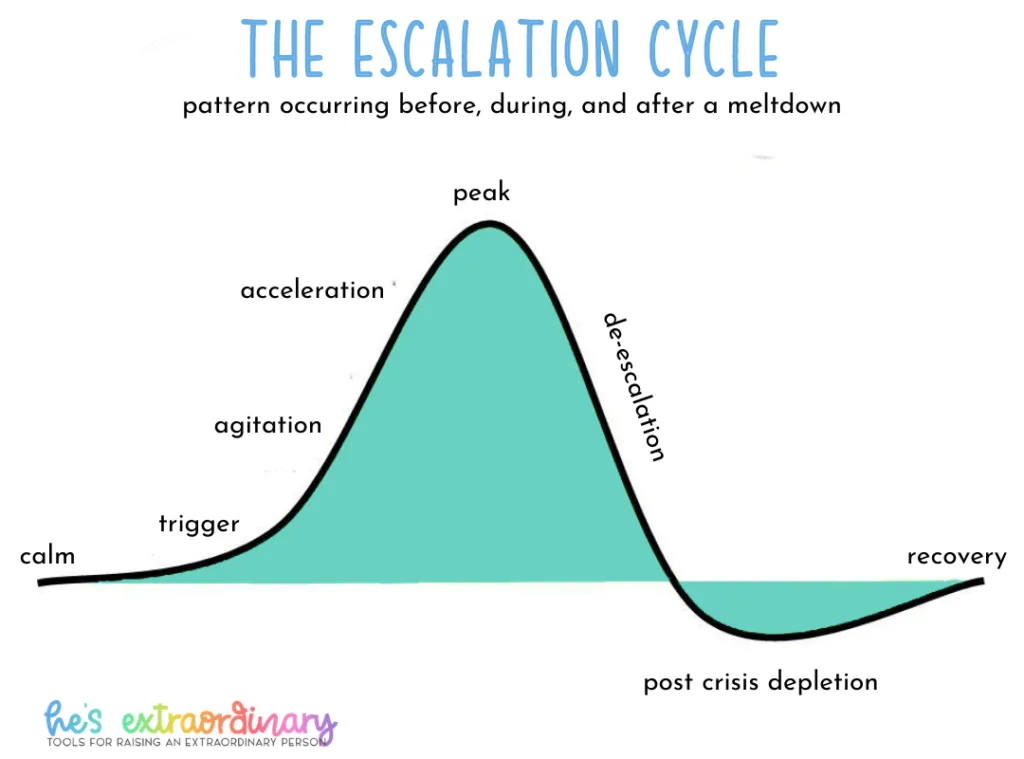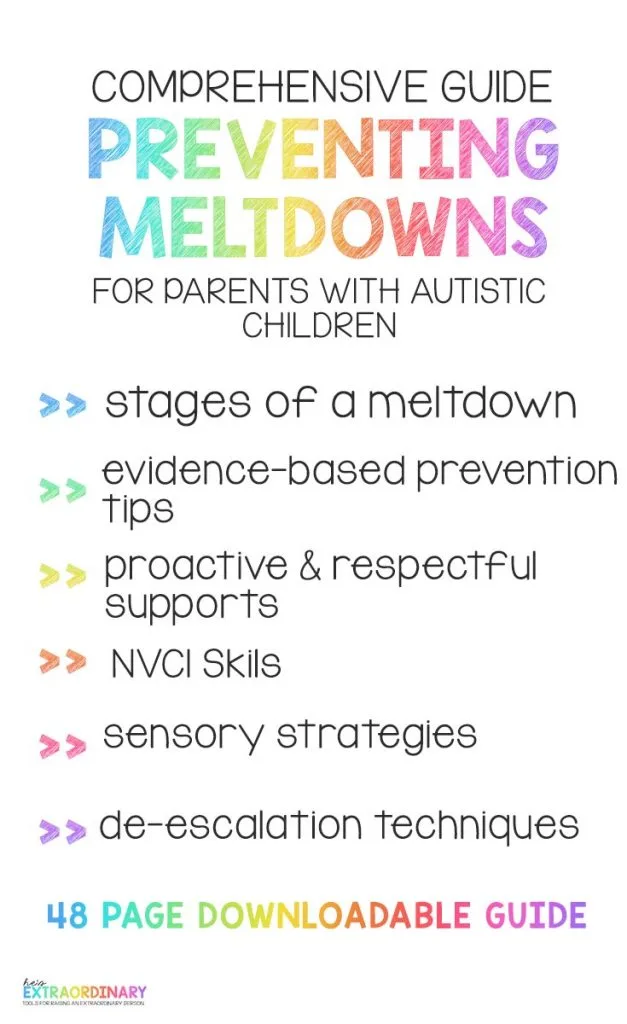What’s inside this article: Any overview of the escalation cycle, in other words, the stages of a meltdown, along with in-depth advice for preventing meltdowns in children with autism.
Disclaimer: This post contains affiliate links.

Meltdowns are no joke, and they’re definitely not “temper tantrums.” If you have ever dealt with a child having a meltdown, then you know that de-escalating the situation is no easy feat. Actually, it’s nearly impossible to stop autism meltdowns once they’ve begun.
A meltdown may seem unpredictable and include aggressive or destructive behavior.
It is very different from a temper tantrum because the child is not in control of themselves during the outburst. So, knowing how to prevent autism meltdowns proactively is a more successful approach than de-escalation.
Disclaimer: This post contains affiliate links.
To be successful at preventing meltdowns, you must be able to:
Anatomy of a Meltdown
The diagram below is a representation of what happens to a person’s emotional state as a meltdown occurs.

First, when a child is calm, they follow directions, ignore distractions, accept praise and feedback. Being calm is the ideal state.
Be sure to also read about these 6 NVCI strategies for handling meltdowns. These strategies are useful at all stages of the escalation cycle.

Calm – Time For Prevention
When your child is calm, you should always focus on preventing meltdowns.
Use positive reinforcement often and give your child opportunities to be successful. Our brain is wired to accept reinforcement better than consequences.
During this time is the perfect opportunity to communicate positive expectations because your child is receptive. You need to teach and practice coping skills and behavior strategies with your child while they are calm. Children can’t learn how to self-regulate when they’re already distressed.
Strategies For When Your Child Is Calm
1. You can do activities that encourage relaxation and de-stressing
You may have trouble getting your child to participate in these calm and quiet activities at first. That is entirely normal, but you can build up the time slowly, like stamina.
For example, if your child is practicing their breathing and is only able to focus for 30 seconds, that’s fine. Give them positive reinforcement for trying. Then push for 35 seconds of breathing on the next day.
It’s essential to practice these activities often when your child is calm so that when they do become upset, you can prompt them to do their breathing then, too. You can’t teach calming techniques to your child mid-meltdown.
2. Proactively address sensory integration issues
Occupational therapists often recommend sensory “snacks” instead of sensory “meals” for kids. This means spending 5 minutes, once an hour, doing a full-body activity, instead of spending 30 minutes a couple of times a day doing activities. Short but frequent intervals are more effective.
3. Plan Your Schedule and Practice Your Exit Strategy
Get more information about using schedules and structuring the environment here.
Trigger: Be Proactive
After a “trigger,” your child is no longer in a calm state. The trigger is the turning point that could lead to a meltdown, depending on what happens next.
You must recognize the trigger when it occurs and start using the
If you realize and intervene at the trigger, there’s an 80-90% chance you can prevent the situation from escalating.
Possible Triggers:
Warning Cues:
These cues may be subtle and require a keen eye to notice. Children have unique cues, and you will know what your child’s signals are better than anybody else.
After a trigger, focus on intervention and redirection to be supportive of non-escalating behavior and prevent the meltdown.
What To Do After A Trigger
After you’ve noticed warning cues and identified the trigger, you need to intervene. Consider some of the following interventions:
1. Remove or modify the trigger
If the trigger is sensory-related, modify the environment, or accommodate the child. You may need to give your child a fidget to use or have a movement break.
Movement helps us get our senses back to the “just right” zone necessary for calm. A change of environment may be needed, or a redirection to a preferred activity.
2. Increase Opportunities for Success
If your child is feeling frustrated after repeated failures – create opportunities where they will be successful. Ask them to do a task you know they can do and increase the amount of positive reinforcement you are using.
The positivity can ease some of your child’s frustration and help them feel calm again.
3. Create a Break Box
Collect 15-20 small items you can keep together as part of your break box. When you start seeing cues that your child is frustrated, allow them to take a short break with their break box to do a calming activity. You can include things like coloring books, fidgets, play-doh, puzzles, word searches, etc.

You should tailor the break box to your child’s interests. It’s easy to create your own by picking up some dollar store items.
We keep our break box in our calm down corner, and a 5-minute break there together often helps reregulate. Check out our calm down corner and our $10 box here.
4. Deal with internal problems promptly
Internal problems take a bit of detective work because children often don’t know how to express what is happening inside their bodies; they may not even know what it is they are feeling.
However, it is imperative because no amount of manipulating the environment will help your child if the problem is internal.
Offer a drink or snack, or ask them if they are in pain or feeling ill. Read more about interoception here.
Agitation – Intervene Now
Once your child reaches a state of agitation, you will start seeing an increase in negative behavior. If you intervene now, you have about a 30-40% chance of preventing the situation from escalating.
During this stage, you will notice behaviors such as:
This is your last chance for intervention if you are going to prevent the meltdown.
When your child is in a state of agitation their frustrations are incredibly close to overflowing into a full meltdown. Their fight or flight instinct is going to take over.
1. Answer the question – why?
What purpose does the behavior have? Understanding why your child is acting a certain way is the key to changing it.
You must understand the function to plan a successful last chance intervention.
2. Make immediate environment modifications
Take your child out of the current environment and go somewhere for a break or take a “time-in”.
A change of scenery can help when calming a child.
If there is a sensory issue, deal with it immediately by removing or modifying the trigger.
3. Give Your Child Reasonable Options/Choices
When a child is frustrated, they often feel like they have lost control of a situation. Offering choices or options can help them feel as though they’ve regained a bit of control.
These choices are things such as “Do you want to walk to the dinner table or do you want to skip there?” “Do you want to wear your purple shirt today, or your green shirt?”
4. Match Your Child’s Language or Stop Talking
When your child is on the verge of a meltdown, communication becomes increasingly difficult to process.
Matching your child’s language can help you make sure you’re talking in a way that they can understand. So if your child speaks to you in two-word phrases, respond in two-word phrases, not full sentences.
Then make sure you’re giving them time to process what you’ve said. If you start repeating yourself before you have given your child time to process what you said the first time they would become more frustrated and unable to follow your instructions.
Processing time increases as levels of stress increase. While waiting for a response, try counting to 5 in your head, before speaking again.
5. Use Positive Engagements
Look for opportunities to use positive reinforcement. As the saying goes, every cloud has a silver lining. Even if your child is acting out, search for the positive in the situation and use it.
Sometimes, adding humor to the situation helps. For example, once my son kicked his shoes off angrily while in the car. I picked his shoes up and used silly voices to make each of his shoes “talk” to him about how they like when he wears them.
It soon had him giggling and I was able to stop the situation from escalating and get him to put his shoes back on.
Acceleration – Escalation Will Run Its Course
Unfortunately, once your child has reached the point of acceleration, the escalation of the meltdown will most likely need to run its course.
You must understand that at this point, your child has lost control of their behavior. This may include things such as:
At this point, maintaining everyone’s safety is the most important thing.
1. Use Non-violent crisis intervention skills
Remove anything that could be potentially dangerous to yourself or your child. Move away from the situation – give them some space while ensuring their safety.
If other people are around, have them leave/move away as well. Do not touch or attempt to move the child unless they are in a dangerous place.
Read this article to learn about six important NVCI skills for parents to use during autism meltdowns.
2. Disengage
Just stop talking.
I can’t stress this enough. At this point, your child cannot process what you are saying. There is no reasoning with them or explaining right now, and they will not be receptive to anything you say.
3. Try De-escalation techniques
The success rate of prevention is far higher than that of de-escalation. However, sometimes it’s unavoidable, so it’s essential to have some de-escalation techniques too.
Click here for 18 de-escalation techniques.
I know some of these techniques may seem more like “what not to do,” but sometimes our responses do nothing but make situations more volatile.
You can also find verbal de-escalation techniques here.
Peak
The peak is the most severe part of the meltdown. Continue the same way as you were during the acceleration while focusing on safety.
Deceleration —-> Recovery
After the peak begins the deceleration. At this point, the behavior becomes less and less severe.
When your child reaches the state of depletion, they will feel drained. During this time, focus on re-establishing your child’s routine and starting anew. Do not nag, blame, punish, or force apologies. Your child is recovering from an extremely stressful event.
After recovery, when your child has returned to their calm state, talk about what happened. This is the ideal time to give any consequences, explain why, and talk about expected behavior. You can work on teaching those replacement behaviors and calming activities that were discussed.
Look back at where things started to go awry and plan what you can do next time to prevent the same escalation from occurring.
How to Successfully Prevent Autism Meltdowns
To successfully prevent autism meltdowns, you must intervene early. Prevention is always ideal, but realistically that is not always possible. Triggers can happen unexpectedly and be unpredictable.
It’s important to be ready to intervene at the earliest sign of frustration. The sooner you begin intervention, the more likely you will be able to stop the behavior from escalating into a full-blown meltdown.
If your child has just had a meltdown, think about the following questions:
Behavior Management Strategies
Challenging behaviors are prevalent with autistic children, but it’s not because they are choosing to be “bad” or wanting to upset you. These behaviors stem from being unable to communicate effectively in other ways.
I created a 30-minute mini-workshop called Meltdown Magic, and that workshop also includes a 50-page guide for preventing meltdowns. You can see the workshop and digital guide here.


Taylor Wright
Monday 6th of January 2020
Thanks for the tips for preventing outbursts. My sister has a son that has autism and needs a way to help him daily. Your tips will help her out and make it easier to help him.